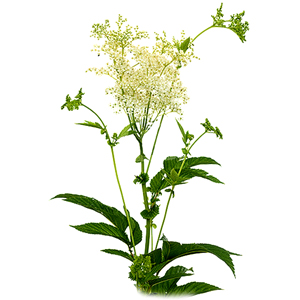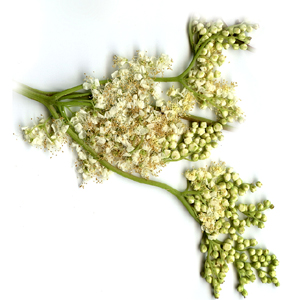No products
Meadowsweet - 50g
Meadowsweet (Filipendula ulmaria) destroys Golden staph (Staphylococcus aureus) and Escherichia coli - the source of many serious diseases. Other effects: antibacterial and astringent (bronchitis, influenza, gout)...
![]()
Content |   |
Binomial nameFilipendula ulmaria Commonly called (often known as)Mead wort StorageStore in a dry place at a temperature up to 25°C |
Description of herb
Meadowsweet (Filipendula ulmaria) is abundant from the lowlands to lower mountain locations, on the wet shores of watercourses and lakes, on wet meadows, springs, in sparse shrubs and in unshaded areas of floodplain forests throughout Europe, western Siberia, Asia Minor , in the Caucasus and Altai regions.
It is called natural Aspirin because it contains the same active ingredient as chemically produced Aspirin in tablets, but unlike it, it also heals the stomach, wounds and kidneys. However, artificially produced aspirin has one major disadvantage compared to Meadowsweet. Meadowsweet has a balanced content of other natural substances and therefore does not irritate the gastric mucosa, on the contrary, it heals it.
Healing effects
Meadowsweet is a source of natural salicylates - spireins (salicylaldehyde and methyl salicylate), from which salicylic acid, known as Aspirin and Acylpyrin, is formed in the body. It has an anti-inflammatory and anti-rheumatic effect, relieves pain and reduces fever.
Its antibacterial and anti-inflammatory effects are used externally to heal wounds as part of healing ointments or for compresses and baths, and internally as a supportive treatment for gastric ulcers.
It is excellent for indigestion, gastric hyperacidity and heartburn.
Tea acts diuretically and against chronic diarrhea. It acts as a weak sedative and brings relief from rheumatic joint pain and inflammation. Thanks to the pleasant aroma, the plant is also used in cosmetics.
Active substances
- Flavone glycosides (spiraeoside, rutin, hyperin)
- Tannins
- Glycosides of phenolic acids
- Essential oils (salicylate, salicylaldehyde)
Properties
Antibacterial, anti-inflammatory, antirheumatic, immunostimulant.
Recommended at
Per oral use helps in these diseases and troubles
- bronchitis
- feverish colds
- flu
- gout
- rheumatism
- bladder diseases
- kidney disease
- metabolic disorders
- high blood pressure
- headaches
- toothache
- joint pain
- reduces the acidity of gastric juices
Preparation and dosing
TEA
Preparation: Cook a tablespoon of 250 ml of boiling water, leave to infuse for 20 minutes.
Dosing: Drink 2-3 times a day
TINCTURE
Preparation: Load 130 g of dried stems for 3 weeks in 1 liter of 50% alcohol. Shake daily, then drain and use.
Dosing: 10 to 15 drops 3 times a day
Side effects
Not recommended for use during pregnancy and lactation. Due to the content of salicylic acid derivatives, the use of the drug is not suitable for children and for people who cannot take salicylates. Otherwise, side effects at normal therapeutic doses are not known.
REMEMBER: Tell all your health care providers about any complementary health practices you use. Give them a full picture of what you do to manage your health. This will help ensure coordinated and safe care.

